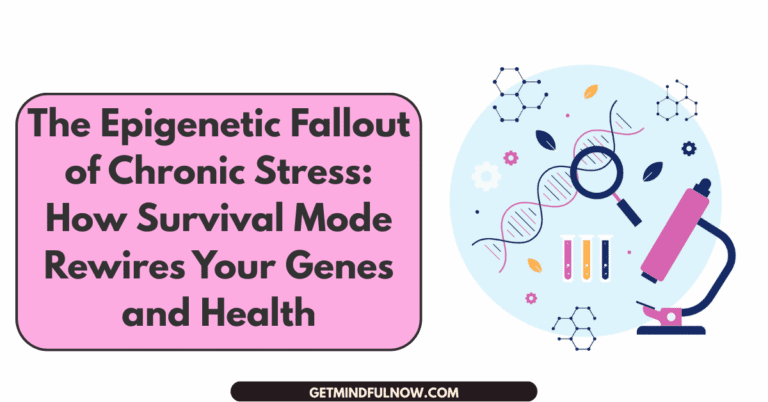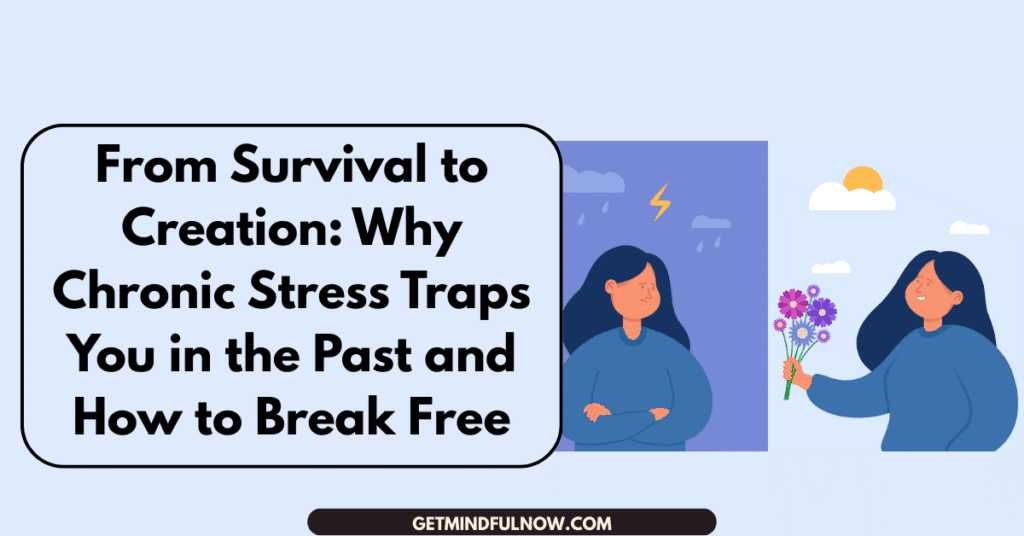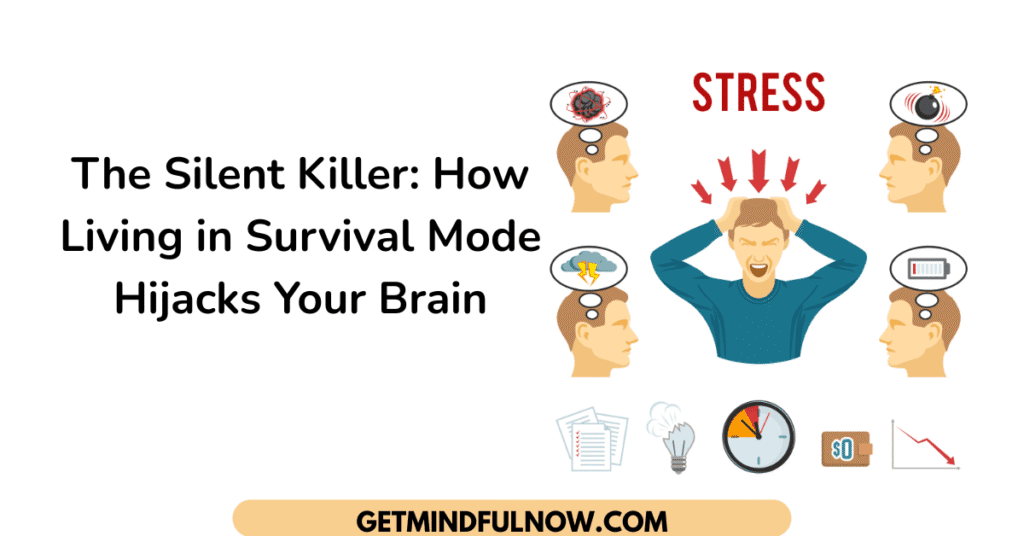I didn’t learn about epigenetics in some classroom, I lived it in my body. After years of trauma stacked on trauma, I thought I was just cursed with bad luck and weak health. But when you grow up wired for survival, constantly hustling, constantly scanning for the next threat, your biology pays the bill. I used to think pushing through was strength. Now I know it was just stress running the show, flipping genetic switches I didn’t even know existed.
Stress doesn’t just make you tired—it rewires your biology
When we are stuck in survival mode, the body runs on adrenaline and cortisol. That’s helpful if you need to slam the brakes to avoid a car crash, or meeting a deadline, or fighting for yourself but not so helpful if you live in that state every day. Science now shows that chronic stress doesn’t just leave you frazzled, it literally changes which of your genes get turned on or off. That’s epigenetics: the study of how life experience shapes genetic expression without changing your DNA sequence.
Think about that for a second. The same DNA you were born with can produce two very different outcomes, depending on the environment inside your body. Survival mode isn’t just about feeling anxious. It’s about flipping genetic switches toward disease, inflammation, and faster aging. That’s a pretty heavy price tag for living on high alert.
Why two people exposed to the same thing don’t always react the same
I remember how Dr. Joe Dispenza, my only mentor of healing journey, explains it with a simple but powerful example: two factory workers can be exposed to the exact same toxin. One gets sick. The other doesn’t. What’s the difference? Their inner environment.
If your system is already flooded with stress hormones, your immune defenses are down, your cells are inflamed, and your genes for healing are switched off. The toxin hits harder. Meanwhile, someone with a calmer inner chemistry has a better chance of handling the same exposure without it turning into illness. The same shock shows up in twin studies too, two people with identical DNA, yet one develops a disease their parent had while the other doesn’t. Again, it’s the inner environment and gene expression that makes the difference.
Research in psychoneuroimmunology shows that chronic stress weakens immune function, making people more vulnerable to infections, autoimmune disorders, and even cancer progression. Two bodies, same outside world, different inside settings.
When survival mode becomes your identity
If you grew up like I did, parentified early, carrying adult responsibilities as a child, living through narcissistic abuse from both parents, and enduring physical and emotional traumas, your nervous system may never have learned what safety feels like. You become the hustler, the overachiever, the one who keeps going even while breaking inside.
Society rewards you for it. But under the surface, stress hormones are carving grooves into your biology. Your body learns chaos so well that peace feels unfamiliar, maybe even uncomfortable. And that wiring doesn’t just vanish, it echoes into your health and, if you’re not careful, even your children’s health.
Epigenetic studies on trauma survivors show this clearly. Children of Holocaust survivors, for example, were found to carry altered stress hormone profiles. That’s the fallout: survival mode is contagious across generations if no one stops to heal it.
PS: That’s also why I don’t want to bring a child into this world right now. People around me, who live in constant stress, sometimes mock me for not having one. I am aware enough to do the reverse work for years, while they are proudly, though unknowingly, passing all their traumas and troubles down to the next generation.
The sneaky way stress makes you feel like a victim
Have you ever wondered why sudden diagnoses hit so hard? Like waking up in your late-twenties or mid-thirties with diabetes, hormonal problems, digestive issues or another medical issue you didn’t see coming. You’ve been doing your best, carrying the load, pushing through like a champion, and then boom, fate sucker-punches you. It’s brutal because it feels unfair. You become a victim twice over: first to the life circumstances that wired you for stress, and second to the biology that stress created. That’s why I always say, surviving isn’t the same as living.
Your inner environment is the control room
Here’s the hope in all this: genes are not destiny. You and I can influence which genetic switches get flipped. Your body is like a control room, full of dials that respond to the signals you send. If you’re constantly thinking stressful thoughts and feeling negative emotions like sadness, hate, competition, anger. eating junk that spikes inflammation, and staying around toxic people and in environments, the dials lean toward disease. But if you create inner safety, do the shadow work, give time to open your heart for elevated emotions, nourish yourself well, and choose new mental and emotional states, you can lean those dials back toward healing and growth.
This isn’t just my personal opinion, it’s backed by science. Studies have shown that meditation, being mindful to your emotional states, opening heart and relaxation practices can downregulate genes linked to inflammation and upregulate those linked to immunity.
One independent study led by Dr. Joe Dispenza took 117 subjects and trained them to feel gratitude three times a day for 15 minutes each, just for three days. The result? Immunoglobulin A (IgA), one of the body’s most robust immune markers, went up by 50%, making the body so strong that even the flu can not touch you. For me, someone who used to be a victim of low immunity, this is no longer theory. I haven’t caught a cold or flu in almost two years, even when people I live with do.
Diet plays a role too: anti-inflammatory foods like leafy greens, omega-3s, and berries support healthier gene expression. Even your social environment matters, research shows strong social support literally buffers the biological impact of stress.
What creating inner safety looks like in real life
So how do we actually flip those switches back? It’s not about buying the perfect supplement stack or moving to a mountaintop (though hey, if that’s your vibe, more power to you). For me, it started with building pockets of inner safety. That looked like long meditations, sometimes hours in a day, where I could drop into theta brainwave states and give my nervous system a break from survival. It also meant choosing nourishing foods, saying no to toxic relationships even if they are your parents or siblings, and cleaning up my environment so my body wasn’t fighting a constant war.
It wasn’t overnight. I had to learn how to stop identifying as “the hustler girl who survives no matter what” and start imagining the version of me who thrives. I had to ask myself: what would my ideal self think, feel, and do each day? Then I had to practice being her. Over and over. Meditation became the rehearsal space where I rewired my biology for peace instead of chaos.
Even today I still live like this: I meditate for at least an hour in the morning and set an intention for the day, and at night I pause and ask myself how I did. I journal the moments I fell short, then love myself even more and promise that next time I’ll do better.
Healing isn’t just personal—it’s generational
One of the most motivating things for me is knowing that the healing we do now doesn’t just stop with us. Remember those epigenetic hand-me-downs? If stress can pass forward, so can healing. When you rewire your inner environment, you don’t just free yourself, you give your children and future generations a blueprint for resilience, not survival mode.
Science backs this too. Animal studies show that when parents are exposed to nurturing environments, their offspring inherit more balanced stress responses. Humans aren’t any different. What we embody, we pass on. That’s powerful responsibility, but also powerful hope. And it’s not only through kids, it’s through teaching and writing like I’m doing with this blog. Healing ideas spread like infection too, only in the best way possible.
Final thoughts
If you’ve been stuck in survival mode, drowning in stress, and maybe even carrying diagnoses that make you feel betrayed by your own body, I see you. I’ve been there. The epigenetic fallout of chronic stress is real, but so is the possibility of rewriting it. Your biology isn’t fixed. Your nervous system isn’t broken beyond repair. And your future isn’t doomed to be a repeat of your past.
You and I have the power to send new signals, to flip different switches, to build an inner environment where healing genes finally have the stage. That’s not just resilience, it’s true transformation. And it’s available to anyone willing to do the work.
If this spoke to you and you’re ready to stop surviving and start rewriting your biology, I’d love to walk alongside you. You can book a one-on-one session with me through my homepage. And if you want more of these raw, science-backed conversations, subscribe to my newsletter and follow me on Threads. Let’s heal not just for ourselves, but for everyone who comes after us.








